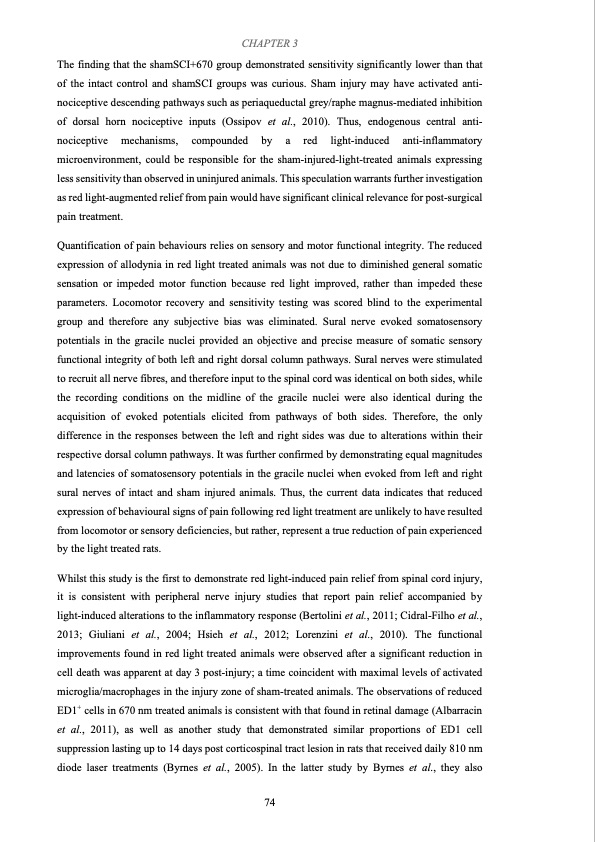
PDF Publication Title:
Text from PDF Page: 088
CHAPTER 3 The finding that the shamSCI+670 group demonstrated sensitivity significantly lower than that of the intact control and shamSCI groups was curious. Sham injury may have activated anti- nociceptive descending pathways such as periaqueductal grey/raphe magnus-mediated inhibition of dorsal horn nociceptive inputs (Ossipov et al., 2010). Thus, endogenous central anti- nociceptive mechanisms, compounded by a red light-induced anti-inflammatory microenvironment, could be responsible for the sham-injured-light-treated animals expressing less sensitivity than observed in uninjured animals. This speculation warrants further investigation as red light-augmented relief from pain would have significant clinical relevance for post-surgical pain treatment. Quantification of pain behaviours relies on sensory and motor functional integrity. The reduced expression of allodynia in red light treated animals was not due to diminished general somatic sensation or impeded motor function because red light improved, rather than impeded these parameters. Locomotor recovery and sensitivity testing was scored blind to the experimental group and therefore any subjective bias was eliminated. Sural nerve evoked somatosensory potentials in the gracile nuclei provided an objective and precise measure of somatic sensory functional integrity of both left and right dorsal column pathways. Sural nerves were stimulated to recruit all nerve fibres, and therefore input to the spinal cord was identical on both sides, while the recording conditions on the midline of the gracile nuclei were also identical during the acquisition of evoked potentials elicited from pathways of both sides. Therefore, the only difference in the responses between the left and right sides was due to alterations within their respective dorsal column pathways. It was further confirmed by demonstrating equal magnitudes and latencies of somatosensory potentials in the gracile nuclei when evoked from left and right sural nerves of intact and sham injured animals. Thus, the current data indicates that reduced expression of behavioural signs of pain following red light treatment are unlikely to have resulted from locomotor or sensory deficiencies, but rather, represent a true reduction of pain experienced by the light treated rats. Whilst this study is the first to demonstrate red light-induced pain relief from spinal cord injury, it is consistent with peripheral nerve injury studies that report pain relief accompanied by light-induced alterations to the inflammatory response (Bertolini et al., 2011; Cidral-Filho et al., 2013; Giuliani et al., 2004; Hsieh et al., 2012; Lorenzini et al., 2010). The functional improvements found in red light treated animals were observed after a significant reduction in cell death was apparent at day 3 post-injury; a time coincident with maximal levels of activated microglia/macrophages in the injury zone of sham-treated animals. The observations of reduced ED1+ cells in 670 nm treated animals is consistent with that found in retinal damage (Albarracin et al., 2011), as well as another study that demonstrated similar proportions of ED1 cell suppression lasting up to 14 days post corticospinal tract lesion in rats that received daily 810 nm diode laser treatments (Byrnes et al., 2005). In the latter study by Byrnes et al., they also 74PDF Image | Effects of Red Light Treatment on Spinal Cord Injury

PDF Search Title:
Effects of Red Light Treatment on Spinal Cord InjuryOriginal File Name Searched:
Thesis_Di Hu_final.pdfDIY PDF Search: Google It | Yahoo | Bing
Cruise Ship Reviews | Luxury Resort | Jet | Yacht | and Travel Tech More Info
Cruising Review Topics and Articles More Info
Software based on Filemaker for the travel industry More Info
The Burgenstock Resort: Reviews on CruisingReview website... More Info
Resort Reviews: World Class resorts... More Info
The Riffelalp Resort: Reviews on CruisingReview website... More Info
| CONTACT TEL: 608-238-6001 Email: greg@cruisingreview.com | RSS | AMP |